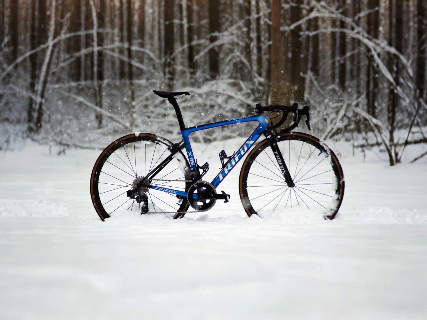
In the world of road cycling, finding the perfect balance between high-performance engineering and everyday practicality can seem like an impossible quest. The Trifox 700C Ultralight Carbon Fiber Road Bike with its S-RIDE 2x11-speed groupset and disc brakes represents that rare sweet spot where race-ready capability meets real-world usability.The Carbon Frame Advantage: Lightweight Yet DurableAt the heart of this remarkable machine lies its full carbon frame road bike construction. Unlike heavier alternatives, this lightweight road bike frame delivers the stiffness-to-weight ratio that serious cyclists demand. What makes this particular frame special is its versatility – the geometry works equally well as a responsive racing bicycle for competitive events or as a comfortable bicycle road bike for weekend adventures.11-Speed Gearing: The Perfect Balance of Range and SimplicityThe 2x11-speed drivetrain represents the ideal compromise in modern road cycling. With 22 available gears, riders have ample range to tackle steep climbs while maintaining optimal cadence on flat sprints. This gearing setup provides the versatility needed for varied terrain without the complexity and weight of more extreme systems.Disc Brakes: Reliable Stopping Power in All ConditionsOne of the most significant practical advantages of this bike is its hydraulic disc brake system. Unlike traditional rim brakes that can suffer in wet conditions, these disc brakes provide consistent, powerful stopping regardless of weather. This safety feature is particularly valuable for riders who commute on their road bikes or ride in changeable conditions.Designed for Real RidersThe thoughtful design extends to every aspect of this bike. The classic bike with drop bars offers multiple hand positions for comfort during long rides, while the carbon frame's geometry accommodates a wide range of body types, making it an excellent option as a womens road bike with appropriate sizing.Exceptional Value PropositionPerhaps most impressively, this bike achieves all this while remaining among the more inexpensive road bikes with genuine carbon construction. By combining a quality carbon frame with proven componentry, Trifox has created a road racing bicycle that delivers 90% of the performance of bikes costing twice as much.The Complete Package for Modern CyclingFrom its responsive carbon frame to its reliable disc brakes and versatile 11-speed gearing, every component of this bike has been selected to create a harmonious whole. It's a carbon frame road bike that doesn't force you to choose between speed and comfort, between performance and practicality.The Trifox 700C Carbon Road Bike proves that you don't need to compromise to get a truly exceptional riding experience. By thoughtfully combining modern materials with sensible design choices, it delivers the performance that excites serious cyclists while maintaining the practical features that make cycling accessible and enjoyable for everyone.
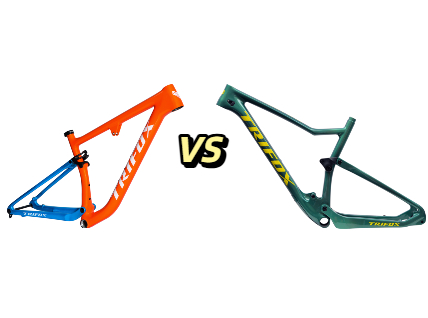
Selecting the perfect full-suspension carbon frame involves balancing multiple technical factors that directly impact your riding experience. Trifox offers two exceptional but distinct options: the Trail II Pro and the MFM100. Both utilize high-modulus carbon fiber and modern engineering, yet differ significantly in their approach to geometry, suspension design, and component compatibility. Understanding these differences will help you choose the frame that best matches your riding style and trail requirements.Geometry & Riding Position: XC Efficiency vs Trail ConfidenceThe MFM100 is engineered for cross-country performance. Its geometry features a steeper head tube angle (around 68–69°) and a shorter reach, creating an upright, efficient pedaling position ideal for climbing and accelerating on undulating terrain. This is a classic XC mountain bike frame philosophy—prioritizing speed and efficiency over sheer stability.Conversely, the Trail II Pro embraces modern trail bike geometry. With a slacker head tube angle (approximately 67–68°) and a longer front center, it positions the rider lower and further between the wheels. This "in-the-bike" stance inspires confidence on steep descents and provides superior stability at high speeds, making it the clear choice for technical, aggressive trail riding.Suspension Design & Installation: A Key DifferentiatorHere lies a major technical distinction. While both frames use a sophisticated four-bar linkage system, their suspension design and shock installation differ to serve their intended purposes.The Trail II Pro typically employs a more traditional shock mount placement, with the shock oriented vertically or at a slight angle between the top tube and the seat stay/chainstay intersection. This layout prioritizes a linear to moderately progressive curve, focusing on pedaling efficiency, mid-stroke support, and quick recovery—perfect for maintaining momentum on climbs and flow trails.The MFM100 often features a low main pivot design with the shock mounted lower in the frame, between the down tube and the front of the swingarm. This configuration, combined with a higher leverage ratio, creates a more progressive suspension curve. It offers greater small-bump sensitivity for traction and ramps up significantly at the end of the travel to handle big impacts without bottoming out harshly. This design favors descending capability and all-mountain performance.Rear Derailleur Hanger: The Critical Link to Your Drivetrain ChoiceThis is a core difference that affects your drivetrain selection and future upgrade path.The Trail II Pro is equipped with a UDH (Universal Derailleur Hanger). This design provides a crucial compatibility advantage. The UDH hanger is a mandatory requirement for installing the SRAM Eagle Transmission groupset—a widely used and beloved wireless electronic shifting system known for its extreme performance, reliability, and simplicity. At the same time, the UDH is fully compatible with all traditional Shimano and SRAM mechanical or electronic derailleurs. Choosing the Trail II Pro means you can freely select any mainstream groupset available today and also have the door open for a future seamless upgrade to the top-tier SRAM Eagle Transmission, ensuring the frame's long-term value and technical foresight.The MFM100 uses a standard, model-specific hanger. This traditional hanger can reliably support Shimano groupsets and all SRAM traditional groupsets except for the SRAM Eagle Transmission. However, it cannot be compatible with the UDH-mandatory SRAM Eagle Transmission. This means that if you wish to upgrade to this popular high-performance wireless groupset in the future, you will be limited. Furthermore, if damaged, you must find a specific replacement that exactly matches this frame model.Weight & Construction PhilosophyAdhering to its XC racing pedigree, the Trail II Pro is the lighterweight carbon frame. Its carbon layup is optimized to shed every possible gram while maintaining precise stiffness for efficient power transfer. It’s designed for riders who count grams and value snappy acceleration.The MFM100, built to endure the rigors of trail and all-mountain abuse, carries a slight weight penalty. This extra mass comes from strategic reinforcement at high-stress points (like the suspension pivots and chainstay yoke) to ensure long-term durability and impact resistance. The weight is a worthwhile trade-off for the resilience it provides.Aesthetic & Color OptionsVisual identity aligns with each frame's purpose. The Trail II Pro often comes in understated, professional color schemes like matte black, charcoal, or navy—reflecting its racing heritage. The MFM100 tends to offer more vibrant, adventurous finishes, such as glossy electric blue, matte olive green, or two-tone combinations, mirroring its trail-ready character.The VerdictYour choice fundamentally depends on your local trails and riding priorities.- Choose the Trifox Trail II Pro if: You live for climbs, value every gram, participate in XC events, or ride trails where pedaling efficiency and quick handling are paramount. Its efficient suspension and lighter weight make it a rocket on climbs and flowing singletrack. The inclusion of the UDH also makes it the only choice if you plan to use or upgrade to the SRAM Eagle Transmission groupset.- Choose the Trifox MFM100 if: Your rides feature challenging descents, technical features, and varied terrain. You value stability, traction, and impact absorption. The progressive suspension and modern geometry make it a robust and confident partner for trail adventures, provided you do not require compatibility with the SRAM Eagle Transmission.Both frames exemplify Trifox's commitment to quality carbon engineering. By carefully weighing their differences in geometry, suspension design, and critical details like the derailleur hanger standard, you can select the carbon foundation that will transform your vision of the perfect mountain bike into reality.```
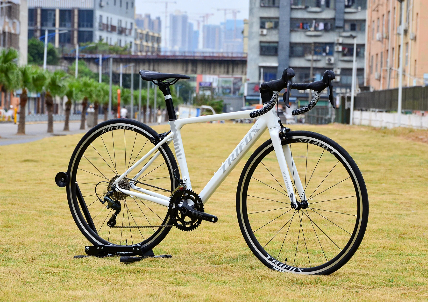
Finding the perfect balance between affordability and performance can be challenging for new road cyclists. The Trifox C-Brake Ultralight Aluminium Frame Road Bike strikes this balance beautifully, offering professional-level features at an accessible price point that's winning over beginners and experienced riders alike.The Perfect Entry Point to Road CyclingFor those starting their cycling journey, this model stands out as one of the best entry level road bike options available. The lightweight aluminum frame provides the responsive ride quality that new cyclists seek, while the proven Shimano Tiagra groupset ensures reliable performance mile after mile. What makes this particular aluminum road bicycle special is its ability to deliver genuine road cycling excitement without the intimidating price tag of professional racing bikes.Designed for Performance and ComfortThe frame geometry strikes an ideal balance between aggressive racing positions and comfortable endurance riding. This makes it an excellent choice as a ladies road bike, with sizing options that accommodate different body types and riding styles. The aero road bike inspired tube shaping not only looks fast but actually improves airflow around the bike, giving you an efficiency advantage whether you're keeping up with group rides or pushing for personal bests.Quality Components That MatterWhile some budget bikes cut corners on components, this alu road bike features a complete Shimano Tiagra 4700 2x10-speed groupset. The precise shifting and reliable braking performance give new riders the confidence to focus on developing their skills rather than fighting with their equipment. The combination of quality components and thoughtful frame design creates a racing bicycle experience that feels far more expensive than its actual price point.Versatility for Different Riding StylesOne of the bike's strongest advantages is its adaptability to various riding disciplines. The responsive nature of the aluminum road bicycle makes it equally suitable for fast club rides, endurance events, or even entry-level racing. The balanced geometry provides stable handling for beginners while still offering the quick reflexes that experienced riders appreciate when pushing the pace.Exceptional Value in Modern Road BikingIn an era where carbon fiber often dominates the spotlight, this bike proves that advanced alu road bike technology continues to offer incredible value. The modern aluminum manufacturing techniques create frames that are both lightweight and durable, perfect for riders who want a low-maintenance bike they can rely on season after season.The Smart Choice for Growing CyclistsFor riders who may eventually progress to more specialized bikes, this model serves as the perfect foundation. The quality construction means it will maintain its value, while the reliable performance ensures it can serve as a dedicated training bike or foul-weather companion down the road. It's not just a beginner bike - it's a smart investment in your cycling future that will continue to deliver enjoyment as your skills and fitness improve.The Trifox Aluminum Road Bike represents everything that's right about modern entry-level cycling. By combining quality materials, proven components, and thoughtful design at an accessible price, it removes barriers to entry while still delivering the authentic road cycling experience that turns newcomers into lifelong enthusiasts.
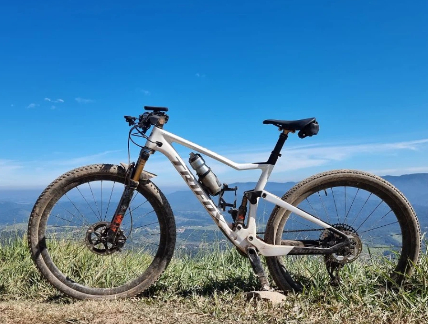
When it comes to conquering varied terrain, from steep technical climbs to flowing descents, having the right equipment makes all the difference. The Trifox 29er Carbon Full Suspension Trail Pioneer Bike represents the perfect balance of climbing efficiency and descending capability, making it an ideal choice for riders looking to master every aspect of trail riding.The Ultimate Trail CompanionA true full suspension trail bike needs to perform equally well going up as it does coming down. The Trifox Trail Pioneer excels in this regard, featuring a lightweight carbon frame that efficiently transfers power during climbs while the suspension system absorbs bumps and maintains traction. This combination makes it not just another mountain bike, but a genuine trail partner that enhances your riding experience regardless of the terrain.Confidence-Inspiring Braking PerformanceModern trail riding demands reliable stopping power, and the mountain bike disc brakes on this bike deliver exactly that. Whether you're navigating technical rock gardens or carrying speed into bermed corners, the hydraulic disc brakes provide consistent modulation and power. This braking performance, combined with the bike's balanced geometry, gives riders the confidence to push their limits while maintaining full control.Cross Country Performance Meets Trail CapabilityWhile many bikes specialize in either climbing or descending, the Trifox Trail Pioneer truly bridges the gap between a pure cross country bike and a capable trail machine. The efficient pedaling platform and lightweight construction make it an excellent xc bike for covering long distances, while the generous suspension travel and modern geometry ensure it remains composed on challenging descents.The 12-Speed AdvantageThe inclusion of a 12-speed drivetrain significantly enhances the bike's capability across varying terrain. With a wider gear range than traditional systems, riders can tackle steep climbs without sacrificing top-end speed on flats and descents. The precise shifting and reliable performance of the 12-speed system ensure you're always in the right gear, whether you're grinding up a technical climb or accelerating out of corners.Exceptional Value in Carbon Full-SuspensionCarbon full-suspension bikes often come with premium price tags, but the Trifox Trail Pioneer challenges this notion by offering what might be the cheapest full suspension mtb with genuine carbon construction and quality components. This accessibility means more riders can experience the benefits of a lightweight carbon frame and capable suspension without breaking the bank.Ready for Whatever the Trail Throws at YouFrom rocky ascents that demand precise technical climbing to flowing descents where speed and control are paramount, this bike is designed to handle it all. The balanced suspension kinematics provide both pedaling efficiency and bump-eating compliance, while the carbon frame offers the perfect blend of stiffness and vibration damping. It's a bike that encourages progression and rewards skill development.The Trifox 29er Carbon Full Suspension Trail Pioneer represents a new era of accessible high-performance mountain biking. By combining carbon construction, capable suspension, and modern components at an attractive price point, it removes barriers to entry for riders seeking to master all aspects of trail riding.
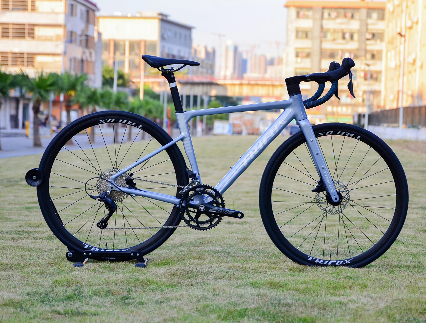
Stepping into the world of road cycling can be both exciting and overwhelming. With countless options available, choosing the right first bike becomes crucial to your cycling journey. The Trifox R241 700C Aluminium Frame Road Bike stands out as an exceptional choice, combining performance, reliability, and value in one package. Here's why a 22-speed disc brake aluminum road bike makes for the perfect first serious ride.The Ideal Balance of Performance and ControlFor beginners seeking their first serious road bike, the 22-speed drivetrain offers versatility across various terrains. Whether you're tackling steep hills or enjoying flat sprints, the wide gear range ensures you'll always have the right cadence. Paired with reliable disc brakes that provide consistent stopping power in all weather conditions, this setup builds confidence for new riders. The aluminum road bicycle frame delivers the perfect blend of durability and responsive handling, making it one of the good road bikes for beginners who want to progress quickly.Why Aluminum Frames Make Excellent Starter BikesAluminum frames have long been the go-to choice for entry-level and intermediate riders, and for good reason. The Trifox R241 features a lightweight aluminum frame that offers exceptional stiffness and power transfer. This means more of your pedaling effort translates into forward motion, giving you that authentic racing bicycle feel without the premium price tag. As an affordable road bike, it delivers performance characteristics that rival more expensive models, making it the best beginner road bike for those wanting to experience true road cycling performance.Disc Brakes: Safety and Reliability for New RidersOne of the most significant advantages of this configuration is the inclusion of disc brakes. Unlike traditional rim brakes, disc brakes provide superior modulation and stopping power, especially in wet conditions. For beginners still developing their bike handling skills, this added safety margin is invaluable. The consistent performance of disc brakes allows new riders to focus on building technique and confidence rather than worrying about braking efficiency.The Perfect Platform for GrowthWhat makes the Trifox R241 particularly special is its ability to grow with you as your skills develop. The quality aluminum frame serves as a solid foundation that can accommodate future upgrades, while the 22-speed gearing provides enough range to challenge you as you become stronger and more confident. It's not just a beginner bike - it's a platform that will support your progression in the sport.Exceptional Value Without CompromiseIn the world of road cycling, it's easy to spend thousands on a high-performance machine. However, the Trifox R241 demonstrates that you don't need to break the bank to get a quality ride. As one of the most affordable road bikes with premium features like a alloy 6061 fork and disc brakes, it offers tremendous value. The alloy fork specifically helps dampen road vibrations, adding comfort to your rides without sacrificing the responsive nature of an aluminum road bicycle.Ready for Your Cycling JourneyStarting your road cycling adventure with the right equipment sets the tone for your entire experience. The 22-speed disc brake aluminum road bike represents the sweet spot for newcomers to the sport - capable enough to handle serious riding, forgiving enough to build confidence, and affordable enough to get you started without second thoughts. It's the best beginner road bike choice for those who are serious about developing their cycling skills while enjoying every mile.The Trifox R241 combines all these elements into a package that's ready to roll. Whether you're looking to join group rides, tackle your first century, or simply enjoy the freedom of road cycling, this bike provides the perfect starting point for your journey on two wheels.

When it comes to optimizing your mountain bike for performance and aesthetics, every component matters. While many riders focus on upgrading suspension or wheels, the mtb bicycle handlebar often remains an overlooked opportunity for transformation. Integrated carbon mountain bike bars, like the Trifox Ultra Light Integrated Full Inner Mountain Bike Handlebar RHB600, offer a revolutionary approach to achieving a cleaner, lighter, and more efficient setup.The Problem with Traditional HandlebarsTraditional mtb bike handle setups often involve multiple parts: the bar itself, a separate stem, and external cable routing. This not only adds weight but also creates a cluttered appearance vulnerable to cable snags and dirt accumulation. For riders seeking a sleek and functional solution, integrated bars present a compelling alternative.Benefits of Integrated Carbon Design1. Cleaner Aesthetics and FunctionalityThe Trifox RHB600 features full internal cable routing, eliminating exposed cables and housing. This streamlined design reduces the risk of snagging on trails and simplifies cleaning. Whether you're navigating dense forests or rocky descents, an integrated mtb cycle handlebar ensures your cockpit remains tidy and functional.2. Significant Weight ReductionCrafted from high-modulus carbon fiber, the RHB600 is exceptionally lightweight without sacrificing strength. By merging the stem and bar into a single unit, it removes redundant materials, making it an ideal upgrade for cross-country and trail riders focused on reducing overall bike weight.3. Optimized Rise for Comfort and ControlAs riser handlebars, the Trifox RHB600 provides a comfortable rise that improves body positioning for technical climbs and descents. This design reduces strain on your wrists and back, allowing for longer, more enjoyable rides.4. Enhanced Stiffness and ResponsivenessIntegrated bars like the RHB600 deliver superior stiffness compared to traditional two-piece setups. This translates to precise steering input and better power transfer, giving you confidence when tackling sharp corners or rough terrain.Why Choose the Trifox RHB600?The Trifox RHB600 isn't just another mountain bike handlebar—it's a meticulously engineered component designed for modern trail demands. Its ergonomic shape, combined with a lightweight carbon construction, ensures durability and performance. The internal routing channels are compatible with dropper posts, shifters, and brake lines, making installation straightforward.Riders who prioritize a minimalist yet high-performance cockpit will appreciate how this bar simplifies their bike's look while elevating its capabilities. Whether you're building a new bike or upgrading an existing one, the RHB600 offers a tangible improvement in both form and function.ConclusionIntegrated carbon mountain bike bars represent the future of cockpit design, and the Trifox RHB600 stands out as a top contender in this category. By eliminating clutter, reducing weight, and improving handling, it addresses the core needs of today's riders. If you're ready to elevate your MTB's performance and aesthetics, it's time to consider making the switch to this innovative integrated carbon handlebar.Upgrade to the Trifox RHB600 and experience the difference a well-designed integrated carbon handlebar can make on the trails.
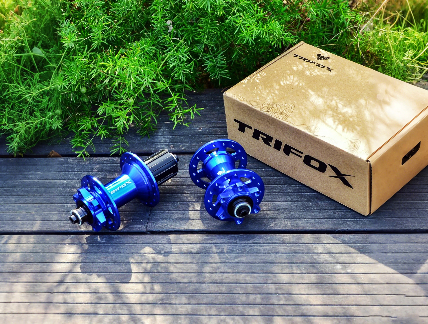
When it comes to mountain bike performance, the hub is one of the most critical yet often overlooked components. While riders frequently focus on upgrading frames or suspension, the humble hub plays a vital role in how your bike accelerates, maintains speed, and handles technical terrain. If you're experiencing any of these five issues, it might be time to consider the Trifox M827 Mountain Bike Hub for your next upgrade.1. Poor Engagement and Power LossModern mountain bike hubs feature high engagement points for instant power transfer. If you're experiencing noticeable delay between pedaling and drive response, or feeling like your power isn't translating immediately to forward motion, your hub's internal mechanism may be worn out. The Trifox M827 hub with its precise 54-tooth engagement system ensures immediate power transfer, making it ideal for technical climbs and sudden acceleration.2. Unusual Noises During RidingWhile some hub noise is normal, new or increasingly loud sounds often indicate problems. Grinding, crunching, or irregular clicking noises suggest that bearings may be contaminated or internal mechanisms are failing. The M827 MTB hub features sealed bearings and precision machining to provide smooth, quiet operation in all riding conditions.3. Visible Play or Wobble in the WheelIf you can feel or see side-to-side movement in your wheel when it's securely mounted, this indicates hub bearing wear. This play affects riding stability and can lead to unsafe handling. The Trifox bike hub is engineered with superior bearing seals and precise tolerances to eliminate play while maintaining smooth rotation.4. Rough Rotation and Increased DragA properly functioning hub should allow the wheel to spin freely with minimal resistance. If your wheel stops spinning quickly or feels rough when rotating, the bearings may be damaged. This friction creates drag that slows you down. The M827 mountain bike hub features low-friction seals and high-quality bearings to maintain smooth spinning and reduce rotational drag.5. Frequent Maintenance RequirementsHigh-quality hubs are designed to require minimal maintenance. If you find yourself constantly adjusting or repairing your current hub, it's likely reaching the end of its service life. The Trifox M827 is built for durability with minimal maintenance requirements, saving you time and frustration while providing reliable performance ride after ride.Why Choose Trifox M827 Hub?The Trifox M827 Mountain Bike Hub represents the perfect balance of performance, reliability, and value. With its 54-tooth rapid engagement mechanism, sealed bearing system, and lightweight construction, it delivers professional-level performance for serious riders. Whether you're tackling technical cross-country trails or aggressive all-mountain routes, this hub provides the instant engagement and reliable performance you need.Compatible with most modern mountain bike standards and available in multiple axle configurations, the M827 makes an excellent upgrade for riders looking to improve their bike's performance without breaking the bank. The hub's durable construction ensures it can handle the demands of aggressive trail riding while maintaining smooth operation.Don't let an aging hub limit your riding potential. Recognizing these five signs early will help you maintain optimal performance and get the most from your mountain bike. Upgrading to the Trifox M827 Mountain Bike Hub is one of the most cost-effective ways to transform your bike's responsiveness and reliability. Experience the difference that quality engineering makes in your next ride.
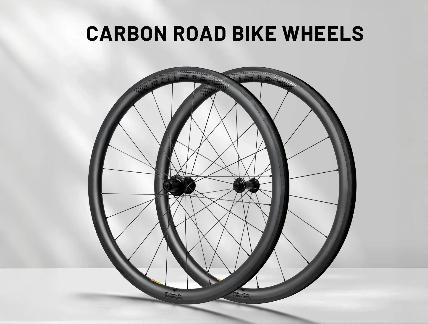
In the world of road cycling, few upgrades deliver as transformative an impact as a quality wheelset. For riders of rim-brake bikes, the Trifox V-Brake Clincher Carbon Wheelset (WT18) represents the perfect fusion of modern carbon technology and traditional braking systems. This combination breathes new life into rim-brake frames, delivering performance benefits that rival even the latest disc-brake setups.Why Carbon Fiber Wheels for Rim-Brake Bikes?The advantages of carbon fiber wheels extend far beyond mere weight savings. While the reduced rotational mass of the WT18 wheelset enhances acceleration and climbing responsiveness, the benefits run deeper. The aerodynamic profile of these deep-section carbon rims helps you slice through the wind with less effort, maintaining higher speeds on flats and descents. For rim-brake bikes specifically, the precisely engineered braking surface ensures consistent stopping power when paired with quality carbon-specific brake pads.Unmatched Compatibility and PerformanceWhat makes the Trifox WT18 wheelset particularly valuable is its dedicated design for rim-brake systems. Unlike universal wheels that compromise on braking performance, these wheels feature optimized carbon brake track for reliable stopping power, clincher design for easy tire installation and maintenance, V-brake compatibility with traditional caliper brakes, and lightweight construction that transforms your bike's character. This focused compatibility means riders can enjoy all the benefits of carbon clincher wheels without worrying about brake performance or installation issues.Transform Your Ride ExperienceThe installation of carbon wheels for rim brake bikes creates an immediate and noticeable improvement in ride quality. The stiffness of the carbon wheel set translates to more efficient power transfer, making every pedal stroke count. Meanwhile, the vibration-damping properties of carbon fiber provide a smoother ride quality, reducing fatigue on longer rides. This combination of responsiveness and comfort makes the WT18 carbon wheels an ideal upgrade for both competitive riders and enthusiastic amateurs.The Smart Choice for Rim-Brake EnthusiastsFor cyclists committed to their rim-brake road bikes, the Trifox V-Brake Carbon Wheelset offers a compelling upgrade path. It demonstrates that you don't need to abandon your trusted frame to enjoy the benefits of modern wheel technology. The carbon V-brake wheels maintain the elegant lines and proven performance of traditional road bikes while delivering contemporary performance advantages. A Partnership That Makes Perfect SenseThe marriage of carbon fiber wheels with rim-brake frames creates a synergistic relationship that enhances every aspect of your ride. The Trifox V-Brake Clincher Carbon Wheelset proves that rim-brake bikes still have plenty of performance potential waiting to be unlocked. Whether you're looking to improve your climbing, gain free speed on flats, or simply refresh your favorite bike, these wheels deliver measurable benefits while maintaining the classic character of your rim-brake machine. Experience the perfect pairing of traditional braking and modern wheel technology – your rim-brake bike will thank you for it.
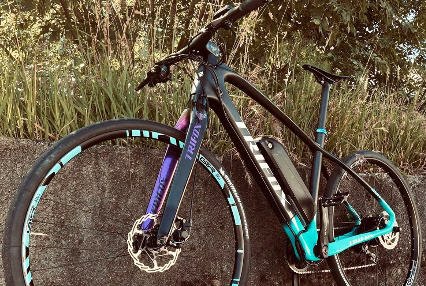
When it comes to mountain biking, control and comfort are non-negotiable. Every trail, every descent, and every technical section demands a fork that can handle the rigors of off-road riding while keeping you in command. Enter the Trifox 29er Disc Brake Tapered Carbon MTB Rigid Fork (Model TA-TMK100)—a game-changer for riders seeking to elevate their MTB experience. In this blog, we'll explore how this fork enhances control and comfort, making it a must-have upgrade for your mountain bike.Lightweight Carbon Construction for Agile HandlingOne of the standout features of this 29er carbon MTB fork is its full carbon fiber construction. Weighing just 600g, this fork significantly reduces bike weight for quicker steering response, easier maneuverability, and less fatigue on long rides. Whether navigating tight singletrack or climbing steep gradients, the reduced weight allows for more agile handling and better control—perfect for cross-country and trail riders who value speed and precision.Tapered Design for Superior Stiffness and StabilityThe tapered carbon fork features an engineered steerer tube that widens at the base to enhance steering precision and reduce flex. This design provides optimal stiffness during high-speed descents and aggressive cornering, giving riders confidence to tackle technical sections with predictable handling and improved stability.29er Compatibility for Smooth Rollover and TractionThe 29-inch wheel compatibility of this 29er rigid fork ensures superior obstacle rollover, maintaining momentum and reducing bump impact. This results in a smoother ride with improved traction, directly translating to better control and comfort on rocky trails or loose gravel surfaces.Disc Brake Compatibility for Reliable Stopping PowerEquipped with disc brake mounts, this ensures consistent, powerful braking in all conditions. The compatibility with modern hydraulic or mechanical disc brakes provides superior modulation and stopping power, crucial for maintaining control on steep descents and wet trails while ensuring rider safety.Vibration Damping for a Comfortable RideCarbon fiber's natural vibration-damping properties make this carbon mountain bike fork exceptionally comfortable. By absorbing high-frequency trail vibrations, it reduces hand fatigue and discomfort, allowing for longer, more enjoyable rides—particularly beneficial on rough terrain where constant vibrations can cause numbness. Sleek Design and Easy InstallationBeyond performance, the Trifox 29er Fork boasts a sleek, minimalist design that complements modern mountain bikes. Its gloss finish and clean lines add a touch of style to any build. Additionally, the fork is designed for easy installation, with compatibility for tapered head tubes and standard 100 * 15mm thru axles. Whether you’re upgrading an existing bike or building a new one, this fork is a straightforward and rewarding addition.The Trifox 29er Disc Brake Tapered Carbon MTB Rigid Fork -TMK100 is a premium upgrade that delivers on both control and comfort. Its lightweight carbon construction, tapered design, and 29er compatibility work together to enhance your riding experience, while its vibration-damping properties ensure a smooth and comfortable ride. Whether you’re a competitive racer or a weekend warrior, this fork will help you tackle trails with confidence and style.Ready to transform your mountain bike? Check out the Trifox 29er Carbon MTB Fork today and experience the difference for yourself!

















